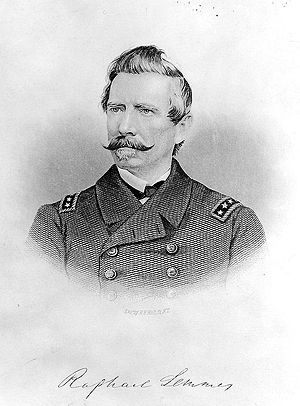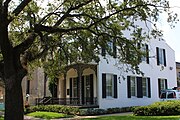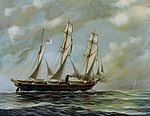| Rear-Admiral Raphael Semmes | |
|---|---|
 | |
| Born | September 27, 1809 |
| Died | August 30, 1877 (aged 67) |
| Place of birth | Charles County, Maryland |
| Place of death | Mobile, Alabama |
| Allegiance |
|
| Service/branch |
|
| Years of service |
USN 1826–1861 CSN 1861–1865 |
| Rank |
|
| Commands held |
USS Somers (Mexican War) CSS Sumter (Civil War) CSS Alabama (Civil War) James River Squadron (Civil War) |
| Battles/wars | |
Raphael Semmes (September 27, 1809 – August 30, 1877) was an officer in the United States Navy from 1826–1860 and the Confederate States Navy from 1860–1865. During the American Civil War he was captain of the famous commerce raider CSS Alabama, which took a record sixty-five prizes. Late in the war he was promoted to rear admiral and also served briefly as a brigadier general in the Confederate States Army. Admiral/General Semmes is the only North American to have the distinction of holding both ranks simultaneously.[1]
Biography[]
Semmes was born in Charles County, Maryland, a cousin of future Confederate general Paul Jones Semmes and Union Navy Captain Alexander Alderman Semmes.[citation needed]
He graduated from Charlotte Hall Military Academy[2] and entered the U. S. Navy as a midshipman in 1826. Semmes then studied law and was admitted to the bar.[citation needed]
During the Mexican-American War, he commanded the brig USS Somers in the Gulf of Mexico. The ship was lost in a storm off Veracruz, Mexico, in December 1846; Semmes was commended for his actions during the loss of the Somers.[citation needed]
Following the war, Semmes went on extended leave at Mobile, Alabama, where he practiced law. He became extremely popular, and the nearby town of Semmes, Alabama was named after him. He was promoted to the rank of commander in 1855 and was assigned to lighthouse duties until 1860. When Alabama seceded from the Union in January 1861, Semmes resigned from the United States Navy and sought an appointment in the fledgling Confederate States Navy.[citation needed]
Confederate States service[]

Captain Raphael Semmes standing by his ship's 110-pounder rifled cannon and his executive officer, 1st Lieutenant John M. Kell, standing by the ship's wheel.
In April 1861 Semmes was accepted into the Confederate Navy as a commander and was sent to New Orleans, Louisiana to convert the steamer Habana into the cruiser/commerce raider CSS Sumter. In June 1861, Semmes, in Sumter, outran the Union sloop-of-war USS Brooklyn, breached the Union blockade at New Orleans, and then launched a brilliant career as one of the greatest commerce raider captains in naval history.[3]
Semmes' command of CSS Sumter lasted only six months, but during that time he ranged wide, raiding U. S. commercial shipping in both the Caribbean Sea and Atlantic Ocean; his actions accounted for the loss of 18 merchant vessels, while always eluding pursuit by Union warships. By January 1862 Sumter required a major overhaul; Semmes attempted to have her repaired in neutral Gibraltar, but the arrival of pursuing Union warships ended her raiding career when they took up blockading stations.[citation needed]
Semmes was forced to sell his ship, and he and his crew then traveled on to England where he was promoted to captain. He then was ordered to the Azores to take up command and oversee the coaling and outfitting with cannon of the newly built British steamer Enrica as a sloop-of-war, which thereafter became world-famous as the Confederate commerce raider CSS Alabama. Semmes sailed on Alabama from August 1862 to June 1864. His operations carried him from the Atlantic to the Gulf of Mexico, around Africa's Cape of Good Hope, and into the Pacific to the East Indies. During this cruise, Alabama captured 65 U. S. merchantmen and quickly destroyed the Union warship USS Hatteras off Galveston, TX.[citation needed]

1864 engraving of the sinking of CSS Alabama
Alabama finally sailed back to the Atlantic and made port in Cherbourg, France for a much-needed overhaul; she was soon blockaded by the pursuing Union steam sloop-of-war, USS Kearsarge. Captain Semmes took Alabama out on June 19, 1864 and met the similar Kearsarge in one of the most famous naval engagements of the Civil War. The commander of the Kearsarge had, while in port at the Azores the year before, turned his warship into a makeshift partial ironclad; the ship's port and starboard midsection were stepped-up-and-down to the waterline with overlapping rows of heavy chain armor, hidden behind black wooden deal-board covers. But Alabama's much-too-rapid gunnery and misplaced aiming, combined with the deteriorated state of her gunpowder and cannon fuses, ensured a victory for both of the Kearsarge's accurate, long-range 11-inch Dahlgren cannons. After receiving a fatal Dahlgren shell to the starboard waterline, which tore open a portion of Alabama's hull, causing her steam engine to explode from the shell's impact, Semmes was forced to order the striking of his ship's Stainless Banner battle ensign and later to display a hand-held white flag of surrender to finally halt the combat. As the commerce raider was going down by the stern, Kearsage stood off at a distance and observed at the orders of her Captain John Ancrum Winslow; Winslow eventually sent rescue boats for survivors after taking aboard Alabama survivors from one of the raider's two surviving longboats. As his command sank, the wounded Semmes threw his sword into the sea, depriving Kearsage's Captain Winslow of the traditional surrender ceremony of having it handed over to him as victor. Semmes was eventually rescued, along with forty-one of his crewmen,[4] by the British yacht Deerhound. He and the forty-one were taken to England where all but one recovered; while there they were hailed as naval heroes, despite the loss of Alabama.[citation needed]

Raphael Semmes
From England, Semmes made his way back to America via Cuba and from there a safe shore landing on the Texas gulf coast; it took his small party many weeks of journeying through the war-devastated South before he was finally able to make his way to the Confederate capital. He was promoted to rear admiral in February 1865, and during the last months of the war he commanded the James River Squadron from his flagship, the heavily armored ironclad CSS Virginia II. With the fall of Richmond, Virginia, in April 1865, Semmes supervised the destruction of all the squadron's nearby warships and was then appointed a brigadier general in the Confederate States Army. His sailors were turned into an infantry unit and dubbed the "Naval Brigade." Their intention was to join Lee's army after burning their vessels. Lee's army, however, was already cut-off from Richmond, so most of Semmes' men boarded a train and escaped to join Joseph E. Johnston's army in North Carolina.[5] A few men of the Naval Brigade were able to join with Lee's rear guard and fought at Sayler's Creek. Semmes and the Naval Brigade surrendered to William T. Sherman and were paroled at Durham Station, N.C. Semmes' parole notes that he held commissions as both a brigadier general and rear admiral in the Confederate service when he surrendered with Gen. Johnston's army.[1] He insisted on his parole being written this way in anticipation of being charged with piracy by the U. S. government.[6]
After the war[]
Semmes was briefly held as a prisoner after the war but was released on parole; he was later arrested for treason on December 15, 1865. After a good deal of behind-the-scenes political machinations, all charges were eventually dropped, and he was finally released on April 7, 1866. After this release, he worked as a professor of philosophy and literature at Louisiana State Seminary (now Louisiana State University), as a county judge, and then as a newspaper editor; his controversial military service was always a factor in forcing his job changes. Semmes later returned to Mobile and resumed his legal career.[citation needed]

Raphael Semmes House on Government Street in Mobile, Alabama, listed on the National Register of Historic Places
He defended both his actions at sea and the political actions of the southern states in his 1869 Memoirs of Service Afloat During The War Between the States. The book was viewed as one of the most cogent but bitter defenses written about the South's "Lost Cause."[citation needed]
In 1871 the citizens of Mobile presented Semmes with what became known as the Raphael Semmes House, and it remained his residence until his untimely death in 1877 from complications due to food poisoning; he was then interred in Mobile's Old Catholic Cemetery.[citation needed]
Raphael Semmes is a member of the Alabama Hall of Fame. One of the streets on the current Louisiana State University campus carries his full name in his honor, as is Semmes Avenue in Richmond, Virginia.[citation needed]
Admiral Semmes' battle ensign[]
The Alabama Department of Archives and History has among its collection an important Confederate naval battle ensign listed as "Admiral Semmes' Flag, Catalogue No. 86.1893.1 (PN10149-10150)." Their provenance reconstruction shows that it was presented to Semmes in England sometime after the sinking of the Alabama by "Lady Dehogton and other English ladies." Such presentations of ceremonial colors were uncommon to ship's captains of the Confederate Navy, but a few are known to have received such honors.[citation needed]
This Stainless Banner Second National Flag of the Confederacy is huge and made of pure silk, giving it an elegant appearance. Although this battle ensign is in a remarkable state of preservation, its very large size and delicate condition has precluded any up-close measurements, so its various details and dimensions are unavailable. When Semmes returned to the South from England, he brought this ceremonial Stainless Banner with him. It was inherited by his grandchildren, Raphael Semmes III and Mrs. Eunice Semmes Thorington. After his sister's death, Raphael Semmes III donated the ensign to the state of Alabama on 19 September 1929.[citation needed]
See also[]
Notes[]
- ↑ 1.0 1.1 Warren F. Spencer, "Raphael Semmes: The Philosophical Mariner, Tuscaloosa: University of Alabama Press, 1997, ISBN 978-0-8173-0844-5, p. 186
- ↑ Maryland. State Board of Education. Twenty-sixth Annual Report of the State Board of Education, Showing the Condition of the Public Schools or Maryland, for the Year Ending July 31st, 1892. Baltimore, MD: Press of Thomas & Evans, 1893, p. xlix.
- ↑ John D. Winters, The Civil War in Louisiana, Baton Rouge: Louisiana State University Press, 1963, ISBN 0-8071-0834-0, p. 48
- ↑ Canon, Jill. Civil War Heroes. Bellerophon Books, Santa Barbara, Calif., 2002, p. 39.
- ↑ Warren F. Spencer, "Raphael Semmes: The Philosophical Mariner, Tuscaloosa: University of Alabama Press, 1997, ISBN 978-0-8173-0844-5, p. 185
- ↑ Warren F. Spencer, "Raphael Semmes: The Philosophical Mariner, Tuscaloosa: University of Alabama Press, 1997, ISBN 978-0-8173-0844-5, p. 189, 194
References[]
| Wikimedia Commons has media related to Raphael Semmes. |
- Alabama Hall of Fame
- Delaney, Norman C. "'Old Beeswax': Raphael Semmes of the Alabama." Harrisburg, PA, Vol. 12, #8, December, 1973 issue, Civil War Times Illustrated. No ISSN.
- Eicher, John H., & Eicher, David J.: Civil War High Commands. Stanford University Press, 2001. ISBN 0-8047-3641-3.
- Gindlesperger, James. Fire on the Water: The USS Kearsarge and the CSS Alabama. Burd Street Press, 2005. ISBN 978-1-57249-378-0.
- Madaus, H. Michael. Rebel Flags Afloat: A Survey of the Surviving Flags of the Confederate States Navy, Revenue Service, and Merchant Marine. Winchester, MA, Flag Research Center, 1986. ISSN 0015-3370. (An 80-page special edition of "The Flag Bulletin" magazine, #115, devoted entirely to Confederate naval flags.)
Primary sources[]
- Semmes, R., CSS, Commander. The Cruise of the Alabama and the Sumter, (two volumes in one), Carlton, Publisher, New York, 1864. Pre-ISBN era.
- Semmes, Raphael (1869). Memoirs of Service Afloat During the War Between the States. pp. 833. ISBN 1-55521-177-1. Url
- Secretary of the Navy. Sinking of the Alabama—Destruction of the Alabama by the Kearsarge. Washington, D.C., Navy Yard, 1864. (Annual report in the library of the Naval Historical Center.)
Further reading[]
- Semmes, Raphael. The Cruise of the Alabama and the Sumter, Carleton, 1864, Digitized by Digital Scanning Incorporated, 2001. ISBN 1-58218-353-8.
- Taylor, John M. Confederate Raider, Raphel Semmes of the Alabama, 1994. ISBN 0-02-881086-4.
External links[]
- Works by Raphael Semmes at Project Gutenberg
This article incorporates text from a publication now in the public domain: Herbermann, Charles, ed (1913). "Raphael Semmes". Catholic Encyclopedia. Robert Appleton Company.
- "Raphael Semmes". Find a Grave. http://www.findagrave.com/memorial/21356. Retrieved 2008-02-13.
- Raphael Semmes article, Encyclopedia of Alabama
"Semmes, Raphael" Appletons' Cyclopædia of American Biography 1900
| |||||||||||||||||
The original article can be found at Raphael Semmes and the edit history here.
